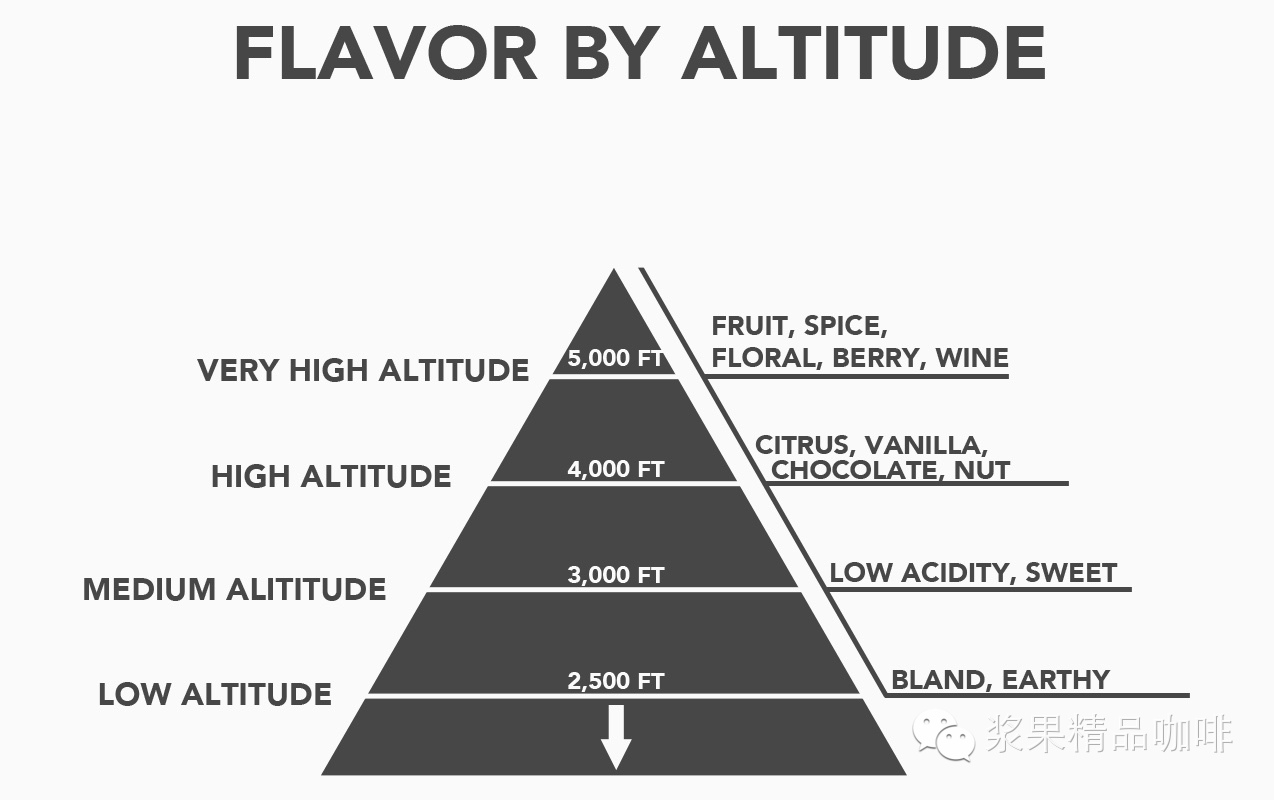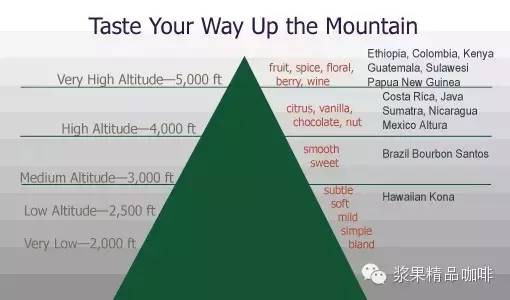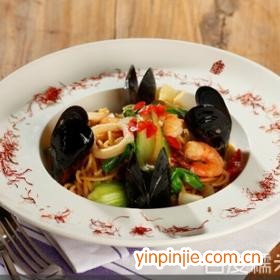 浆果即将翻译的文章,摘自美国知名咖啡杂志「ROAST MAGAZINE」2015年4月8日由美国著名咖啡达人Shawn Steiman投稿。他一生研究咖啡种植,他是生物学博士后,为咖啡种植专研一生。他深入研究咖啡科学,如咖啡的生产、昆虫学、生态学、生理学等等学科,从而优化咖啡品质以及煮咖啡工艺。
浆果即将翻译的文章,摘自美国知名咖啡杂志「ROAST MAGAZINE」2015年4月8日由美国著名咖啡达人Shawn Steiman投稿。他一生研究咖啡种植,他是生物学博士后,为咖啡种植专研一生。他深入研究咖啡科学,如咖啡的生产、昆虫学、生态学、生理学等等学科,从而优化咖啡品质以及煮咖啡工艺。
 在翻译他的文章之前,想和大家说明一个英语问题。Altitude和Elevation有什么区别。虽然两者皆为「海拔」的意思。"Altitude is typically only used to describe the height of an aircraft in flight. It is a barometric measurement expressed relative to the height of a runway or mean sea level in a given location or region (taking into account current local atmospheric conditions), or to an arbitrary standard datum (to eliminate the effect of localised variations in air pressure).Elevation is usually used to describe the height of the ground, or a feature fixed to the ground. It is a geometric measurement expressed relative to the mean sea level datum established for the region by the national mapping agency."简单的说,Altitude就是真正的以海平面为基准的高度,而Elevation是以地球上某一个地面的垂直距离,也就是「地拔」。晓得了伐?好了,以下是译文:What’s So important about High-Altitude Coffee?高海拔种植咖啡为啥那么有逼格?It is pretty common to hear people talk about the importance of growing coffee at high elevations. Advertisements for mountain grown coffee date back more than 50 years and coffee companies still brag about coffees that come from high elevations. It makes you wonder if there’s something magical about mountainsides or being far away from the sea.不少人都认为咖啡种植的海拔高度是非常重要的。50多年前就开始有好多咖啡种植的产区开始宣称自己的咖啡是高海拔种植的,至今太多的、以营利为目的地咖啡贸易商经常编造自己的咖啡为高山种植咖啡来矇骗消费者。就像国内很多的「高山红米」「高山茶叶」一样,都是骗人的把戏。这就让人遐想那些高山咖啡是不是仙人种的,还是“在那山地那边、海地那边有一群蓝精灵”种的。As it turns out, the scientific data is equivocal on the subject. Some research demonstrates a difference in taste as elevation changes while some does not. Many people in the coffee industry, including this author, have experience that suggests different altitudes produce different cup profiles; coffees grown higher up tend to be more acidy and complex while lower elevations tend to be more intensely coffee flavored. If there really is a difference in elevation, what’s going on? 然而,事实证明,科学证明这种学说不完全值得信任。有些科学数据虽然证明根据海拔的高地豆子的风味有所改变,但是有些数据也是不能证明这一点的。很多咖啡业界人士,包括笔者本人,通过他们的工作经验可以证明出不同海拔的豆子在杯测时确实反响不同。咖啡业界人士均发现海拔越高的豆子的酸度越高并且味谱越複杂。但是令人惊奇的是,仍然有些低海拔的豆子风味十足。如果真如本文题目所云,那为何却又如此异议?
在翻译他的文章之前,想和大家说明一个英语问题。Altitude和Elevation有什么区别。虽然两者皆为「海拔」的意思。"Altitude is typically only used to describe the height of an aircraft in flight. It is a barometric measurement expressed relative to the height of a runway or mean sea level in a given location or region (taking into account current local atmospheric conditions), or to an arbitrary standard datum (to eliminate the effect of localised variations in air pressure).Elevation is usually used to describe the height of the ground, or a feature fixed to the ground. It is a geometric measurement expressed relative to the mean sea level datum established for the region by the national mapping agency."简单的说,Altitude就是真正的以海平面为基准的高度,而Elevation是以地球上某一个地面的垂直距离,也就是「地拔」。晓得了伐?好了,以下是译文:What’s So important about High-Altitude Coffee?高海拔种植咖啡为啥那么有逼格?It is pretty common to hear people talk about the importance of growing coffee at high elevations. Advertisements for mountain grown coffee date back more than 50 years and coffee companies still brag about coffees that come from high elevations. It makes you wonder if there’s something magical about mountainsides or being far away from the sea.不少人都认为咖啡种植的海拔高度是非常重要的。50多年前就开始有好多咖啡种植的产区开始宣称自己的咖啡是高海拔种植的,至今太多的、以营利为目的地咖啡贸易商经常编造自己的咖啡为高山种植咖啡来矇骗消费者。就像国内很多的「高山红米」「高山茶叶」一样,都是骗人的把戏。这就让人遐想那些高山咖啡是不是仙人种的,还是“在那山地那边、海地那边有一群蓝精灵”种的。As it turns out, the scientific data is equivocal on the subject. Some research demonstrates a difference in taste as elevation changes while some does not. Many people in the coffee industry, including this author, have experience that suggests different altitudes produce different cup profiles; coffees grown higher up tend to be more acidy and complex while lower elevations tend to be more intensely coffee flavored. If there really is a difference in elevation, what’s going on? 然而,事实证明,科学证明这种学说不完全值得信任。有些科学数据虽然证明根据海拔的高地豆子的风味有所改变,但是有些数据也是不能证明这一点的。很多咖啡业界人士,包括笔者本人,通过他们的工作经验可以证明出不同海拔的豆子在杯测时确实反响不同。咖啡业界人士均发现海拔越高的豆子的酸度越高并且味谱越複杂。但是令人惊奇的是,仍然有些低海拔的豆子风味十足。如果真如本文题目所云,那为何却又如此异议? Any athlete will tell you that the air in thinner at higher altitudes. This is because there’s lower air pressure up there (the weight of all the air that presses down on everything), causing less oxygen to be present in any given breath of air. Plants, however, don’t seem to care much about this. While nobody has tested the effects of different air pressures on coffee plants, researchers doing space research (astronauts need to eat, right!?) have shown that lettuce leaves changed somewhat when grown in different air pressures. However, none of the research examines the taste. Radishes, on the other hand, barely responded at all to different air pressures (unless the air pressure is very, very low). More interesting, the flavor of radishes and some chemical markers that stand in for flavor, didn’t change when the radishes were grown in different air pressure conditions. Lettuce (leaves) and radishes (roots) are different types of plant organs than coffee (seeds), so it is hard to draw a strong comparison from these examples. However, considering the nature of the changes in lettuce and coffee being a seed, it is unlikely that air pressure is influencing the cup quality of coffee.所有的长跑运动员都会告诉你,海拔越高空气越稀薄。只是因为海拔越高,气压越低,从而导致空气中的氧气含量降低。但是,对于植物来讲,低气压对于他们却不是那麽重要。至今为止,没有一个人做过咖啡树根据气压的改变从而受影响的程度的实验。就好比太空人要吃饭一样,他们会因为吃什麽而改变他们是人麽?但是有人对生菜在不同气压下种植时叶子的变化进行了专项研究,妈的,研究有个屁用,那些人根本没有品嚐生菜味道的变化。还有一些人无聊地研究根类蔬菜代表萝卜在不同压力下的生长状况,除非气压非常非常的低会发生「死掉」的状况外,其馀也没有什麽不同之处。那麽,叶类作物代表生菜和根类作物代表萝卜与咖啡这一胚胎类作物相对比都没有显著的区别,但是毕竟咖啡浆果是要处理成生豆,再烘培,再冲出一杯美味的咖啡,这麽複杂的工序那说明海拔或多或少还是会影响咖啡的品质的。A change in air pressure is only one difference that happens at higher altitudes. The other is that the temperature drops. It has been well documented that temperature affects many aspects of plant growth and development across a range of species, including food plants like coffee. As air pressure seems not to be too important in influencing coffee’s taste, it is reasonable to assume, then, that the change in temperature at higher elevations is what is influencing our brew.大气压强的变化对于海拔高低来讲只是其中的一个变数。还有一个可能被大家忽略的就是气温。海拔越高,温度越低。在这一点上已经是有据可查的。温度对很多农作物的生长和种植都是有很大的影响的,当然也包括咖啡。如此看来海拔高低从而改变大气压强是不怎麽会影响咖啡口感的,但是高海拔地区的低温真的在影响我们口中的咖啡了。
Any athlete will tell you that the air in thinner at higher altitudes. This is because there’s lower air pressure up there (the weight of all the air that presses down on everything), causing less oxygen to be present in any given breath of air. Plants, however, don’t seem to care much about this. While nobody has tested the effects of different air pressures on coffee plants, researchers doing space research (astronauts need to eat, right!?) have shown that lettuce leaves changed somewhat when grown in different air pressures. However, none of the research examines the taste. Radishes, on the other hand, barely responded at all to different air pressures (unless the air pressure is very, very low). More interesting, the flavor of radishes and some chemical markers that stand in for flavor, didn’t change when the radishes were grown in different air pressure conditions. Lettuce (leaves) and radishes (roots) are different types of plant organs than coffee (seeds), so it is hard to draw a strong comparison from these examples. However, considering the nature of the changes in lettuce and coffee being a seed, it is unlikely that air pressure is influencing the cup quality of coffee.所有的长跑运动员都会告诉你,海拔越高空气越稀薄。只是因为海拔越高,气压越低,从而导致空气中的氧气含量降低。但是,对于植物来讲,低气压对于他们却不是那麽重要。至今为止,没有一个人做过咖啡树根据气压的改变从而受影响的程度的实验。就好比太空人要吃饭一样,他们会因为吃什麽而改变他们是人麽?但是有人对生菜在不同气压下种植时叶子的变化进行了专项研究,妈的,研究有个屁用,那些人根本没有品嚐生菜味道的变化。还有一些人无聊地研究根类蔬菜代表萝卜在不同压力下的生长状况,除非气压非常非常的低会发生「死掉」的状况外,其馀也没有什麽不同之处。那麽,叶类作物代表生菜和根类作物代表萝卜与咖啡这一胚胎类作物相对比都没有显著的区别,但是毕竟咖啡浆果是要处理成生豆,再烘培,再冲出一杯美味的咖啡,这麽複杂的工序那说明海拔或多或少还是会影响咖啡的品质的。A change in air pressure is only one difference that happens at higher altitudes. The other is that the temperature drops. It has been well documented that temperature affects many aspects of plant growth and development across a range of species, including food plants like coffee. As air pressure seems not to be too important in influencing coffee’s taste, it is reasonable to assume, then, that the change in temperature at higher elevations is what is influencing our brew.大气压强的变化对于海拔高低来讲只是其中的一个变数。还有一个可能被大家忽略的就是气温。海拔越高,温度越低。在这一点上已经是有据可查的。温度对很多农作物的生长和种植都是有很大的影响的,当然也包括咖啡。如此看来海拔高低从而改变大气压强是不怎麽会影响咖啡口感的,但是高海拔地区的低温真的在影响我们口中的咖啡了。 To support this, we must consider that, across the globe, temperature is influenced not just by elevation. A major factor is latitude. As the distance from the equator increases, temperatures at a given elevation decrease. So, 2500 feet above sea level in Hawaii is a much cooler climate than 2500 feet above sea level in Colombia. Whereas coffee grown in Hawaii at that elevation can be acidy and complex, it is rarely found to be so in Colombia, even though the elevation is the same. While many factors influence the flavor of a cup of coffee, the temperature at which it grows seems to be one of them. Thus, looking at elevation alone is not very useful, rather, the interaction of altitude and latitude and their influence on temperature is what matters.为了证实这一点,我们必须在全球范围内考虑海拔对咖啡种植的影响,而不是地拔。因为地拔不一定会影响温度,而海拔一定会。其中重要原委之一便是纬度。当以赤道为中心南北纬度增加时,在相同地拔的温度降低。因此一个最显著的例子便是:海拔两千五百英迟(800米)的夏威夷之气候要比海拔两千五百英迟(800米)的哥伦比亚的气候凉爽的多。因此,在夏威夷那里种植的咖啡酸度更高、风味更複杂。但是在哥伦比亚绝非如此,即使是海拔和地拔几乎接近同一数值。如此看来,温度只是影响咖啡风味的其中一个因素,因此只看咖啡种植的地拔是非常不科学的,相反,海拔和纬度的相互作用以及它们对温度的影响是最重要的。读完了Shawn的文章,似乎懂得了无论做任何事情,都要持之以恒,寻根溯源。否则便只会机械地去做无用功,去创造一些保量却不保质的无用功。浆果坚信,当你把一件複杂的事情做简单的时候,你的内心会无比的空虚和寂寞;当你把一件简单的事情做複杂的时候,你才会找到人世间的真谛,任何事,所有事。
To support this, we must consider that, across the globe, temperature is influenced not just by elevation. A major factor is latitude. As the distance from the equator increases, temperatures at a given elevation decrease. So, 2500 feet above sea level in Hawaii is a much cooler climate than 2500 feet above sea level in Colombia. Whereas coffee grown in Hawaii at that elevation can be acidy and complex, it is rarely found to be so in Colombia, even though the elevation is the same. While many factors influence the flavor of a cup of coffee, the temperature at which it grows seems to be one of them. Thus, looking at elevation alone is not very useful, rather, the interaction of altitude and latitude and their influence on temperature is what matters.为了证实这一点,我们必须在全球范围内考虑海拔对咖啡种植的影响,而不是地拔。因为地拔不一定会影响温度,而海拔一定会。其中重要原委之一便是纬度。当以赤道为中心南北纬度增加时,在相同地拔的温度降低。因此一个最显著的例子便是:海拔两千五百英迟(800米)的夏威夷之气候要比海拔两千五百英迟(800米)的哥伦比亚的气候凉爽的多。因此,在夏威夷那里种植的咖啡酸度更高、风味更複杂。但是在哥伦比亚绝非如此,即使是海拔和地拔几乎接近同一数值。如此看来,温度只是影响咖啡风味的其中一个因素,因此只看咖啡种植的地拔是非常不科学的,相反,海拔和纬度的相互作用以及它们对温度的影响是最重要的。读完了Shawn的文章,似乎懂得了无论做任何事情,都要持之以恒,寻根溯源。否则便只会机械地去做无用功,去创造一些保量却不保质的无用功。浆果坚信,当你把一件複杂的事情做简单的时候,你的内心会无比的空虚和寂寞;当你把一件简单的事情做複杂的时候,你才会找到人世间的真谛,任何事,所有事。版权信息:以上文章转自公众号【浆果精品咖啡】,转载请注明出处原文翻译: 浆果夫妇侵权请联系: weixin@coffeesalon.com投稿合作: tips@coffeesalon.com
 一年一度国际大展HOFEX将于5月6-9日在香港会展中心举行。详情请浏览:
一年一度国际大展HOFEX将于5月6-9日在香港会展中心举行。详情请浏览: http://hofex.com/zh-hans/
http://hofex.com/zh-hans/ 手机浏览中华饮品届
手机浏览中华饮品届













